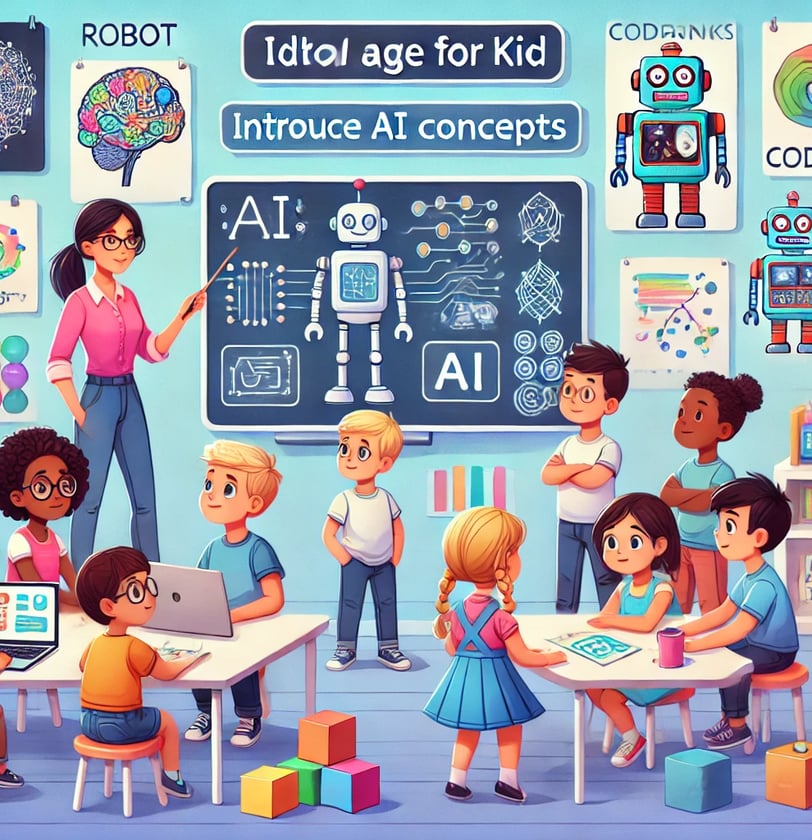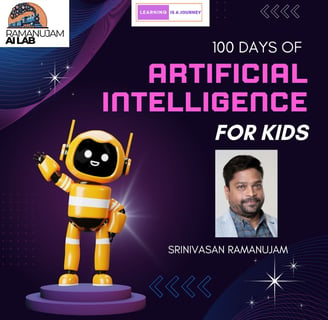Knowledge is the fuel that powers the train of progress.
Ideal Age for kids to Introduce AI Concepts
Introducing AI concepts to children at the right age can have a profound impact on their cognitive development, creativity, and problem-solving abilities. But when is the right time? Let’s explore the ideal age to start teaching AI and coding to kids, backed by practical examples, educational research, and psychological insights.
Srinivasan Ramanujam
9/19/20244 min read
Day 2: The Ideal Age to Introduce AI Concepts to Kids
Introducing AI concepts to children at the right age can have a profound impact on their cognitive development, creativity, and problem-solving abilities. But when is the right time? Let’s explore the ideal age to start teaching AI and coding to kids, backed by practical examples, educational research, and psychological insights.
Why Early Introduction is Key: Cognitive and Psychological Benefits
Early Brain Development: Research shows that between the ages of 5 and 7, children are highly receptive to learning new concepts. Their brains are at a stage where they're developing problem-solving skills, logical thinking, and pattern recognition—all of which are crucial for understanding AI and coding.
Psychological Insight: At this age, children are naturally curious and eager to explore. Introducing AI in a playful way taps into their innate desire to experiment and discover. It also builds a growth mindset, where kids learn to embrace challenges and mistakes as part of the learning process.
Critical Thinking and Logic Formation: Studies indicate that early exposure to coding enhances children’s ability to think logically. Learning AI, which involves understanding how systems make decisions and recognize patterns, builds these skills even further.
Example: Consider a simple coding game like Scratch. A 6-year-old might use it to build a basic animation, learning how sequences and decisions work. While they may not fully grasp the complex algorithms of AI, they begin to understand cause-and-effect relationships, which are fundamental to AI programming.
Developing Creativity and Innovation: When AI is introduced in a fun, interactive way, it allows children to combine creativity with logic. By building simple AI models, they start to see how their imaginative ideas can be turned into real-world solutions.
Example: A 7-year-old can play with an AI toy like Cozmo, a robot that learns and adapts to its environment. By teaching Cozmo to recognize faces or solve puzzles, kids not only engage in creative play but also start grasping basic AI principles like learning and adaptation.
The Ideal Age Range to Introduce AI
Ages 4-7: Sparking Curiosity Through Play
At this age, children are still developing foundational skills like basic reading, math, and spatial reasoning. While they may not yet be ready for complex coding, introducing AI concepts through simple games and toys can spark curiosity.
Practical Example: A child using Cubetto, a toy robot that teaches basic coding logic through physical blocks, will understand sequencing and commands. This is a precursor to understanding how AI processes decisions.
Psychological Benefit: At this stage, children enjoy cause-and-effect relationships, which helps them grasp early coding principles and develop an interest in problem-solving.
Ages 8-10: Building Logical Thinking with Simple Coding
As children’s cognitive abilities develop further, they become ready to handle more structured learning. This is the perfect time to introduce coding through platforms like Scratch or Blockly, which offer drag-and-drop interfaces that simplify programming concepts.
Practical Example: An 8-year-old can create simple games where characters interact based on specific rules. By modifying these rules, children start thinking about "if-then" logic—similar to how AI models work.
Psychological Benefit: At this age, children love exploring patterns and rules. By engaging with AI and coding, they strengthen critical thinking, logical reasoning, and computational thinking skills.
Ages 11-13: Diving Deeper into AI Concepts
Around this age, kids are capable of understanding more abstract concepts. This is a great time to introduce them to real AI tools like Teachable Machine (from Google), where they can train their own simple AI models. This hands-on experience shows them how AI recognizes patterns and makes decisions based on data.
Practical Example: A 12-year-old can use Teachable Machine to teach an AI model to recognize pictures of animals. They can experiment by feeding the AI different types of images, learning how the model "trains" itself to make accurate predictions.
Psychological Benefit: This age group loves experimenting and seeing real results. Hands-on projects foster a sense of accomplishment, while the AI process encourages perseverance and creative problem-solving.
Practical Examples of Introducing AI Concepts by Age Group
1. Age 5-7: Gamified Learning
Activity: Introduce Code-a-Pillar, a toy that teaches young kids about sequencing and programming through playful commands.
AI Concept: While it’s not pure AI, it introduces the idea of programming sequences and decisions in a tangible, age-appropriate way.
Outcome: Children develop early problem-solving skills and gain exposure to the fundamental logic of programming.
2. Age 7-9: Visual Programming
Activity: Use platforms like Scratch to build a simple game or animation.
AI Concept: Kids can learn the basics of how decisions are made in code, which sets the stage for understanding more complex AI models later.
Outcome: Through trial and error, children begin to appreciate logic and computational thinking, key building blocks for AI.
3. Age 10-12: Simple AI Experiments
Activity: Introduce tools like Google’s Teachable Machine or MIT’s AI2 Starter, where children can create simple machine learning models.
AI Concept: They can train a model to recognize objects, faces, or sounds, which teaches them about data input, pattern recognition, and AI training.
Outcome: Kids start to understand how AI learns from data and adapts, giving them a deeper understanding of machine learning.
Psychological Reasons Why Parents Should Introduce AI Early
Encourages Lifelong Learning: Children who engage with AI early are more likely to develop a curiosity for learning new technologies as they evolve. They won’t be intimidated by the complexity of AI in the future because they’ll have built a foundation.
Boosts Confidence: Early success in AI and coding helps children build confidence in their problem-solving abilities. When they see the results of their work—whether it’s a simple game or a functioning robot—they’re motivated to tackle more complex challenges.
Prepares for Future Job Markets: AI skills are becoming increasingly essential, not just in tech fields but across all industries. Parents who encourage early AI education are giving their children a head start in acquiring future-ready skills.
Why Start Now?
Introducing AI concepts to children early—whether through play or structured learning—equips them with crucial 21st-century skills like critical thinking, problem-solving, and creativity. Starting with gamified learning for young children and gradually building toward real AI models as they grow ensures that their curiosity and abilities develop in parallel. For parents, this is not just about keeping children engaged; it's about preparing them for a future where understanding AI will be as essential as reading or math.
Stay tuned for Day 3: "Real-Life Examples of Children Excelling with Early AI Exposure"—where we’ll explore inspiring stories of young AI learners creating their own innovative projects!








